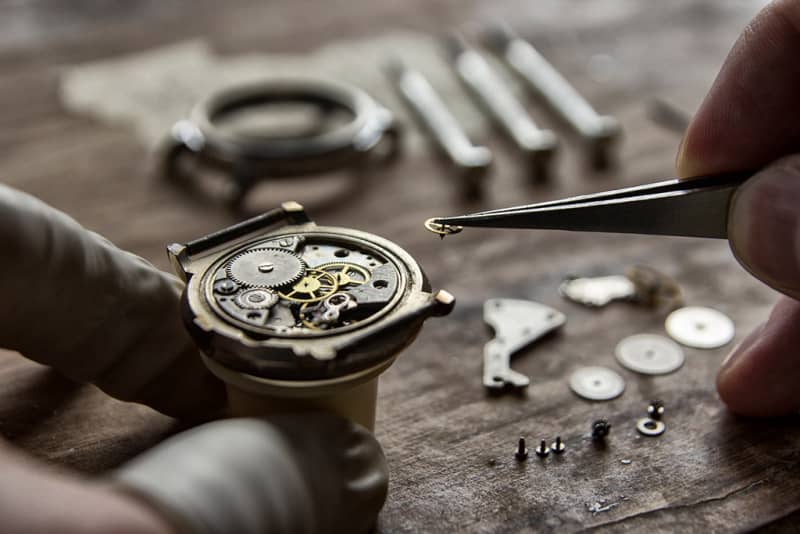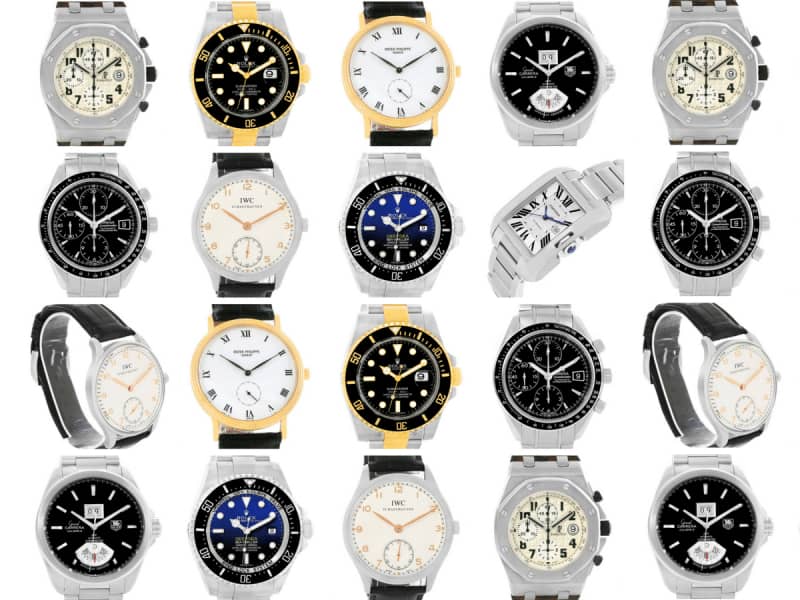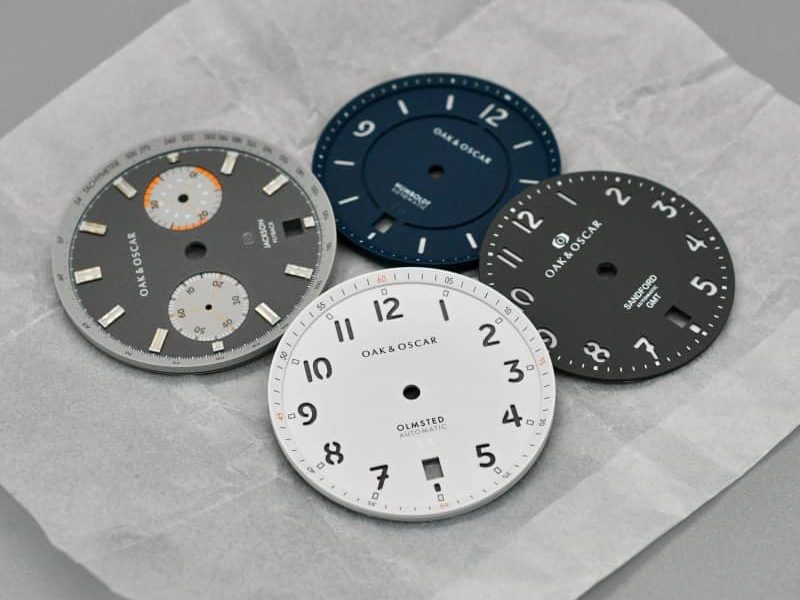If you are a watch enthusiast or a professional watchmaker, then you’re deeply familiar with the critical role the balance wheel plays in regulating time. As the beating heart of a mechanical watch, the balance wheel functions much like a pendulum, swinging back and forth to regulate the power released from the mainspring. Understanding and maintaining this component is crucial to ensuring the precision and longevity of your timepieces.


ال balance wheel is a marvel of micro-engineering composed of several key components that work in harmony:
Any slight imperfection or imbalance in these parts could lead to a significant variance in time accuracy. Therefore, sourcing high-quality watch parts is a priority for professional watchmakers and repairers.
While we’ve briefly touched upon the wheel rim in the previous section, it is essential to delve deep into this specific watch part’s intricate details and functionality. The wheel rim plays a critical role in maintaining the overall balance and precision of the timepiece.
The wheel rim, primarily made up of metal alloys, comprises of a rounded edge consistently and meticulously machined for precise measurements. Certain high-end timepieces often have wheel rims with split bi-metallic variants, adjusting and compensating for temperature variations.
The principal function of the wheel rim is to hold the balance spring, thereby adding inertia and facilitating its smooth oscillation around the balance staff. The wheel rim’s weight and distribution play a significant role in maintaining the watch’s accuracy, further influenced by the phenomenon of physical inertia.
In terms of accuracy, the wheel rim holds paramount importance. The distribution of weight within the rim directly impacts the balance wheel’s oscillatory motion, that ultimately regulates the timekeeping function. A well-constructed wheel rim ensures that the movement of the balance wheel remains undeterred, leading to a high-performance and precise timepiece.
The need for skilled craftsmanship cannot be overstated when manufacturing the wheel rim, as even a slight variation can impact the watch’s overall functionality. Therefore, as a watchmaker or repairer, procuring top-quality wheel rims should be a priority when ordering watch parts.
In conclusion, the wheel rim is an essential component not to be overlooked in the complex maze of watch parts. Appreciating this element’s subtle nuances gives a greater understanding of the art of watchmaking and the intricacy involved in maintaining timepiece precision.
The width of the wheel rim, as well as the chosen material, also plays into the watch’s overall timing performance. The wider the rim, the higher the inertia, which helps maintain the balance wheel’s regular oscillation. As for the material, metals with high density such as brass or steel provide additional stability in maintaining the oscillation rates.
Always keep in mind, the choice of the right watch parts, their quality, and their strategic assembly can be a defining factor in the success of your timepiece designs or restoration projects.
When it comes to ensuring the smooth operation of a timepiece, the role of watch springs cannot be underestimated. These vital components work as a powerhouse for your beloved watch, storing and releasing energy to regulate the timekeeping functions.
Just imagine, for a moment, a car without an engine. It may look nice on the outside, but without its core operating device, it’s merely a beautiful piece of art with no functionality. Watch springs are akin to that engine, empowering your timepiece to fulfill its primary function: accurate time telling.
ال النابض الرئيسي is the primary spring in a mechanical timepiece. Would you believe it if we were to tell you that this tiny strip of metal is responsible for keeping your watch ticking for hours on end, even days sometimes? Well, it is true. Wound either manually or automatically, this coiled spring stores the kinetic energy that’s transferred gradually to ensure precise timekeeping.
Another crucial spring in a timepiece is the balance spring or hairspring. Attached to the balance wheel, it’s the harmonic oscillation of this spring that controls the speed at which the wheels of the watch turn, hence dictating the movement of the watch’s hands. Much like the beating of a heart, the rhythmic vibrations of the hairspring maintain the accuracy of a mechanical watch.
Note: The precision and durability of a watch largely depend on the quality of these springs. Therefore, as a watchmaker or repairer, it’s pivotal to source high-quality watch parts to ensure optimal functionality of the timepieces you work on.
Manufacturers throughout history have experimented with varying materials to produce quality balance springs, seeking ones that can withstand friction, resist changes due to variations in temperature, and provide exceptional elasticity. Here, we’re going to take a closer look at some of the most commonly used materials in the composition of balance springs.
| مادة | Advantages | Disadvantages |
| Steel | Durable, cost-effective, easily available | Responsive to temperature changes, susceptible to magnetism |
| Nivarox | High resistance to magnetism and temperature variation, superior durability | More expensive, not as widely available |
| Silicium | Extremely resistant to temperature changes and magnetism, lightweight | More costly, requires specialized handling during repairs |
It’s important to us that you, as a watchmaker or repairer, know how to choose the right balance spring for your needs. Whether you’re restoring a vintage timepiece or working on a contemporary model, the material of the balance spring can have a significant impact on the watch’s performance. As a retailer committed to your success, we offer a wide range of balance springs made from different materials for you to choose the perfect component for precise timekeeping.
Further regulating this oscillation is another key component – the hairspring, or sometimes called a balance spring. This spring controls the swing of the balance and keeps the watch operational. Essentially, the number of these oscillations every hour impacts how precisely a watch can keep time. The more these oscillations happen, the more accurate the watch becomes. So, it’s clear that these oscillations need to be carefully regulated.
Let’s demystify the popular oscillation rates:
The fascinating world of watches revolves around these minute oscillations, ensuring every second is accounted for. Investing in durable and reliable watch parts can enhance the lifespan and performance of your timepieces. As a trusted watch parts retailer, we are glad to guide you through this vibrant journey of horology.

ال balance staff of a watch is a critical central component that intersects the balance wheel. Comprised of expertly crafted assets, these parts help ensure accuracy and longevity in your watch’s performance. Although their size is small, their impact on a timepiece’s functionality is monumental.
The balance staff is a slender axle that holds the balance wheel, roller and impulse pin. At one end of the staff is the balance wheel, intricately designed to oscillate back and forth with precision. On the other end lies the pivot, resting on a delicate jewel bearing, minimizing friction and ensuring fluid movement of the balance wheel. This high level of sophistication demonstrates the meticulous craftsmanship that goes into every watch part we sell.
Every time the balance wheel oscillates, it rotates the balance staff, while the roller and impulse pin interact with the pallet fork to transmit power, controlling the release of energy from the mainspring. This precise interaction powers the hands of the watch, accurately measuring each passing second. A slight imperfection or damage to the balance staff can drastically lower the timekeeping precision of a watch. This is where quality watch part replacements come into play.
Due to the dramatic impact slight damage can have on timekeeping, the balance staff often needs to be replaced or repaired during watch servicing. Quality, precision, and proper fit are critical in selecting a replacement balance staff. Thus, trust in our fine selection of balance staffs is essential. We supply many different balance staff models manufactured from high-quality materials, ensuring long-lasting performance and precision for every repair or modification.
To keep accurate time, a watch requires perfect harmonic oscillation of its balance wheel, an achievement reached by the precise fitting, alignment, and performance of the balance staff. Therefore, when selecting a new balance staff, pay close attention to compatibility with your watch’s brand, model, and specific movement. By doing so, you ensure not only the continuation of precise timekeeping but also the longevity of the watch’s overall performance.
In conclusion, the balance staff is a highly crucial part that plays an under-the-radar, yet strong, role in the watch’s mechanisms. Investing in superior-grade balance staff replacements and relying on our expertise can aid substantially in maintaining the watch’s performance and durability in the long run.
Understanding the precise adjustment of a timepiece’s balance wheel is integral to the smooth operation of your watch. The balance wheel’s adjustment affects the regularity of the watch’s ticking motion, or the fundamental beat of the timepiece, consequently impacting its accuracy.
When your timepiece is not keeping accurate time, the balance wheel might need adjustment. The balance wheel, working in partnership with the balance spring, functions as the timekeeper of your watch. When perfectly balanced and tuned, the balance wheel ensures the consistency of your timepiece’s motion. However, even a slight variation in balance can reflect significantly on your timepiece’s timekeeping accuracy.
With these steps, one can identify and rectify time-keeping inaccuracies caused by an unbalanced wheel. Remember, fine adjustments to the balance wheel should ideally be performed by an experienced watchmaker or repairer, to maintain the integrity of your timepiece. By offering high-quality watch parts, we are committed to supporting professionals in the field.
Become a master of time, by understanding the craft, precision, and intricacies involved in watchmaking and repair; starting with the balance wheel adjustment, arguably the heart of a watch’s mechanism.
As a watchmaker or watch repairer, having the الأدوات المناسبة لعجلة التوازن adjustment is essential in ensuring precision and maintaining the timekeeping integrity of a watch. Whether you’re dealing with luxury timepieces or everyday watches, these tools allow you to skillfully address issues that may come up in relation to the balance wheel’s functionality.
The balance truing caliper is one piece of essential equipment, offering insights into how the balance wheel spins. It’s designed to hold the balance wheel securely while measuring for abnormalities or imperfections. This tool enables the identification of any issues in the balance wheel that could be throwing it off its accurate timekeeping rhythm.
Adjusting tweezers, the unsung heroes of the watch repair toolkit, allow for intricate work on tiny watch parts. Their precision makes them ideal for small adjustments to the balance wheel. On the other hand, watch oils help reduce friction, providing a smoother operation and prolonging the life of the watch mechanism.
ال balance cock/table holder is another key tool. It’s designed to hold the balance wheel and hairspring assembly securely to ensure they are not damaged while under inspection or during adjustments.
Magnetism can significantly affect the operation of a watch, causing the balance wheel to behave erratically. Demagnetizers offer a solution to this problem by removing any unwanted magnetic fields from your watch parts, and are an essential addition to your watch repair toolkit.
Apart from using these tools, seeking an understanding of how to effectively gauge the balance wheel’s performance can also enhance your proficiency as a watch repairer. In this profession, expertise is built over time through continuous learning and practice.
Having a comprehensive understanding of the workings of the balance wheel and the tools used for its adjustments equips you with the necessary skills to handle watch repairs and maintenance. Remember, the accuracy of a watch hinges on a perfectly balanced wheel, and knowing how to achieve this balance is a testament to your mastery as a watchmaker. Using the correct tools and techniques can significantly improve the watch’s accuracy – and protect it for the future.
A prime way to understand more about watch mechanisms, the parts used, and their relevance in watchmaking and repair is by posing frequent questions in the industry. Here, we have compiled a list of common queries and their concise answers to offer more insight into this fascinating field.
Brass, steel, and ruby are common in the manufacture of various watch parts. However, silicon, ceramics, and composite materials are becoming increasingly popular for their lightness, strength, and resistance to magnetism and wear.
Essential tools for watch repair include screwdrivers, tweezers, a spring bar tool, and a watch case back opener. Having these tools in your arsenal makes most basic repair tasks much easier.
The larger the balance wheel, the longer its oscillation period. This can improve the watch’s precision, but it’s also more susceptible to shocks and requires a longer power reserve to maintain motion. Hence, the size of the balance wheel is one the many factors affecting the watch’s accuracy.
In watch movement, the hairspring, also known as the balance spring, has a critical role. This incredibly fine coiled spring ensures the balance wheel oscillates back and forth at a constant frequency, thus regulating the watch’s timekeeping function.
Various types of springs are used within watches, but two significant types have been highlighted in this article. The Main Spring stores the kinetic energy used to power the timepiece, and the Hairspring or Balance Springcontrols its timekeeping function.
A balance staff can break due to a heavy blow or shock to the watch. For instance, if a watch is accidentally dropped, the balance staff’s fragile pivot points can easily snap, causing the balance wheel to seize up. This highlights the importance of careful handling and proper protective casing.
إن الآلية المعقدة لكل ساعة هي عمل فني. كل ساعة فاخرة لها مستوى من الحرفية والجودة. تم إنشاء كل منها فنيًا بواسطة صانعي الساعات الخبراء مما يجعل الساعة ذات تصميم أنيق ودقة في ضبط الوقت. لكن جامعي الساعات الفاخرة يفضلون الحركات الميكانيكية أو الأوتوماتيكية. اسمح لنفسك بالانخراط في أحد أنواع حركة الساعة وشارك أفكارك أدناه إذا كانت لديك رؤية مختلفة!

حقوق الطبع والنشر © 2018 سوفلي المحدودة



اترك رد
لن يتم نشر عنوان بريدك الإلكتروني. الحقول المطلوبة مشار إليها *